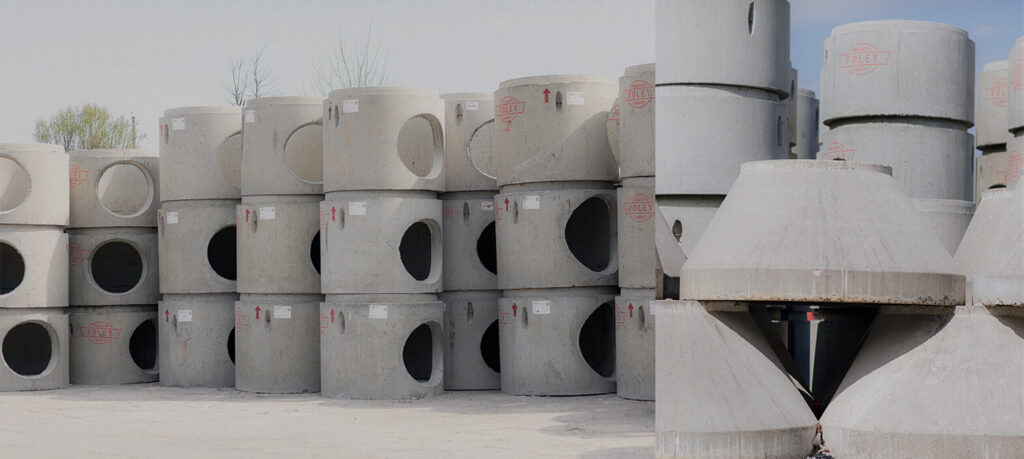Manholes are probably one of the last things that come to mind when we think of urban infrastructure. These underground access points play a vital role in keeping processes running smoothly. Be it drainage systems, accessing sewers, utility networks, or specialized underground pipelines in industries, these hidden structures make modern life possible.
In today’s blog, we will answer some key questions about manholes and which one – precast manholes or fiberglass — is better. So keep reading until the end.
What’s coming up:
- What is a Manhole
- Uses of Manholes
- Precast Manholes
- FIberglass Manholes
- Which One Should You Choose
What Is a Manhole?
A manhole, also known as a utility or maintenance hole, is an opening to a closed space. For instance, a shaft, a utility vault, or a large vessel. They are usually used as access points to an underground utility. Think of water, sewers, telephone lines, electricity, district heating or gas. Manholes make maintenance, inspections, and system upgrades of these utilities easier.
Uses of Manholes
You may think that maintenance holes are just holes in the ground. That’s not true. Manholes are engineered structures essential in almost every sector where underground utilities are installed. Here are a few examples for you to understand better.
1. Sewer Systems
Manholes are installed at regular intervals along the sewer lines, especially at points where pipelines change directions or gradients. In case of blockages, routine checks, or repairs, the crew can easily carry out their operations without removing entire pipe sections.
2. Utility Networks
Another vital role of manholes is in the power and telecommunication industry. They function as access chambers for underground cables, keeping the sensitive equipment safe and easy to access for upgrades or during emergencies.
3. Industrial Application
How do industries manage to house specialized pipelines? These pipelines are not installed in the open. Instead, they are connected underground and accessed via manholes. Chemical plants and refineries are good examples of such industries.
4. Transportation
Highways, airports, and rail systems leverage manholes for various reasons. For instance, drainage, power conduits, and communication lines. If they were absent, it would be disruptive and costly to keep them up and running efficiently.
Precast Manholes
Precast manholes, like the name suggests, are made from precast concrete components. They are relatively standard in construction for three key benefits:
- Efficiency
- Durability
- Easy installation
Instead of casting the entire manhole on-site, precast manholes are engineered in a controlled factory environment and assembled on-site. Since they arrive ready to install, they are a fast and reliable solution.
Wait, why reliable? Well, a controlled factory environment allows for consistent quality and uniformity. Furthermore, they can withstand heavy loads, resist corrosion, and give long-term structural support.
Popular Industries
Precast manholes are commonly used in the following industries and sectors:
- Municipal infrastructures for sewers, storm drains, and water distribution pipelines.
- Highways, airports, and railway drainage systems.
- Power and gas utilities require heavy-duty, load-bearing access.
Advantages of Precast Manholes
Given their design and the industries that install them, the following are some key benefits of precast manholes:
- Strengthened with steel reinforcements, they are suitable for roadways and high-traffic areas.
- They last for decades with proper installation practices.
- Their long-term support often offsets the high initial costs.
- Depending on your project requirements, they can be manufactured in different sizes and configurations because they’re made in a controlled factory environment.
Challenges You May Face
Like two sides of the same coin, precast manholes come with unique challenges. The good thing is that these challenges are not too hard to overcome.
- They’re extremely heavy. This requires special arrangements for transportation and installation.
- The concrete may degrade without protective coatings, especially in sewer systems with high chemical exposure.
- Placement requires cranes or heavy machinery, which may add to project costs and installation timelines.
Fiberglass Manholes
Fiberglass manholes are made of fiberglass-reinforced plastics (FRP), which makes them durable, corrosion-resistant, and easily installable. They’re becoming a preferred choice, especially for modern waste and wastewater management.
These manholes are constructed by molding or fabricating layers of fiberglass and resin according to your choice of shape and size, making them largely customizable. Their lightweight nature and chemical resistance set them apart. Moreover, manufacturers may add UV-resistant coatings to prevent damage from sunlight in exposed areas.
Popular Industries
Fiberglass manholes are popular in industries where concrete manholes may be compromised. Let’s take a look below.
- Industrial plants handling chemicals, petroleum, or wastewater.
- Treatment plants that are exposed to corrosive gases like hydrogen sulfide.
- Telecommunications and electrical setups where lightweight and non-conductive materials are prerequisites.
- Areas of remote installation where you cannot transport heavy materials easily.
Advantages of Fiberglass Manholes
Some of the key advantages of fiberglass manholes are:
- Fiberglass maintains its integrity over time, resisting wear and tear. This durability translates to significant cost savings as the need for repairs and replacements reduces significantly.
- They are exceptionally resistant to corrosion. Thus, it is a no-brainer choice for environments involving aggressive or contaminated fluids.
- They significantly reduce installation time and labor required.
- Given its light weight, fiberglass manholes minimize the risk of injury during installations.
Challenges You May Face
- May have higher initial costs.
- Although strong, it does not meet the capacity of a precast manhole to manage heavy loads.
- Requires skilled technicians to restore its structural integrity if it gets damaged.
Which One Is Better For You?
The answer to your question depends on many factors. We’ve listed and reasoned them below.
1. Location and Load Requirements
If you are going to install the manhole in an accessible high-traffic area or in conditions where it will have to bear a heavy load, a precast manhole is the choice. However, if the area is remote and has transportation limitations, you may have to work with a fiberglass manhole.
2. Environmental Conditions
If your area of operation is highly corrosive, such as chemical plants, wastewater treatment facilities, or coastal areas, fiberglass should do very well. However, in a standard municipal sewer system, a precast manhole may suffice with protective linings.
3. Project Timelines
If you’re looking to reduce the time spent on transportation and installation, a fiberglass manhole seems like a winning option.
Conclusion
The best manhole for you will balance durability, longevity, and performance! Each type may come with certain challenges. However, the difficulty of these challenges should be adequately accounted for before making the decisions. Think about long-term performance over short-term wins.
Contact NaranPPC manufacturers for excellent precast concrete manholes, well-suited for roadways, parking lots, pavements, or commercial applications. They can be quickly designed and installed on demand with minimal effort.

